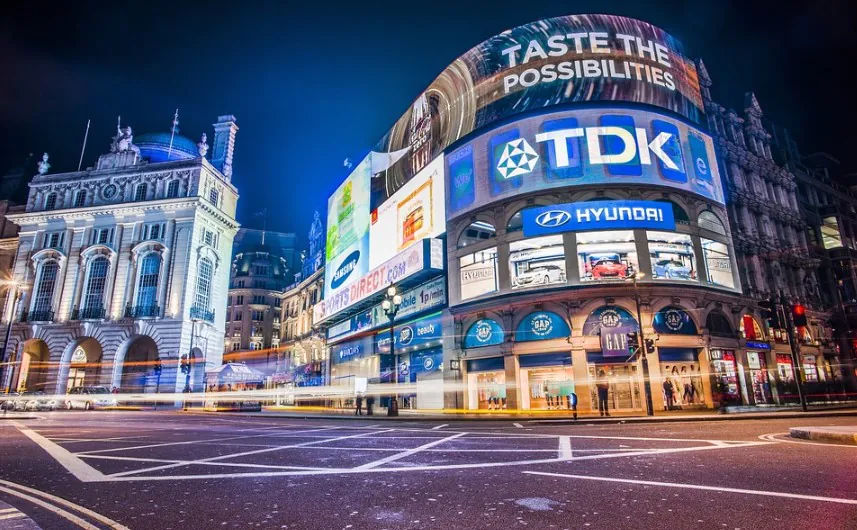The pandemic has had a significant impact not only on advertising spending and revenue, but also on the types of advertising that marketers are prioritizing. 2021 saw significant recovery for the advertising industry after the challenges of 2020, and growth is expected to continue through 2022. While some advertising trends and practices adopted during the pandemic will become less common as restrictions ease, others will continue to spread throughout the industry in the coming years.
Global Advertising Industry Overview
Global advertising revenue totalled over US$763 billion in 2021 according to Statista, and is expected to surpass US$1 trillion by 2026. North America is the largest market for advertising, with Asia-Pacific close behind. Print advertising expenditures continue to decline, but digital advertising is flourishing: the segment was valued at US$455 billion in 2021 and is expected to pass US$645 billion by 2024.
Mobile online advertising in particular is the fastest-growing segment in the industry, with China leading the world in spending on the segment. The country puts 92% of its digital advertising spending into mobile advertising, while the global average is 74%. With the high penetration of the internet and growing access to it in developing countries, digital advertising strategies are a higher priority than ever, especially as people spend more time at home due to COVID-19.
Access Free Advertising Industry Insights
What Can Advertisers Expect from 2022?
Pressures from the pandemic have begun to lift, but the industry is still feeling the effects, and current advertising trends reflect that. Marketing budgets fell in 2020 as companies dealt with lower revenues and higher costs, and while recovery is well underway, COVID-19 continues to make an impact. According to research by Gartner, there has been a significant move from advertising agencies to in-house teams in order to reduce costs. As countries reopen and people leave the home more frequently for both work and leisure, online traffic and engagement have fallen somewhat from their 2020 levels, meaning that marketers will have to take this dip into account when planning budgets and strategies.
Despite the challenges remaining for the advertising industry, there are many opportunities to take advantage of. Here are some of the advertising trends and tactics companies are using in 2022.
New Strategies for Video Ads
Online video is a key focus for advertisers, with a large percentage of consumers watching video content online weekly or even daily. However, most users don’t want long video ads, with many closing an ad after only 10-20 seconds. Videos also do best on social media when they are under one minute long. Advertisers are therefore trending towards shorter video ads, with some creating ultra-short content with the aim of engaging the viewer before the “skip” button appears on platforms like YouTube.
Another emerging video advertising trend is to de-emphasize audio or remove it entirely. The majority of consumers don’t like video ads that play sound automatically, and many users (especially those on mobile) will not engage with a video that requires sound to get its message across. On platforms like Facebook and LinkedIn, most videos are played with the sound off. Advertisers are therefore making heavier use of captions and graphics in order to get their message across even if the viewer never unmutes the video.
A Focus on Mobile
With the number of mobile internet users continuing to grow globally, mobile advertising is an important segment to focus on. Over half of global web traffic comes from mobile devices, according to Statista, and since the start of the pandemic people have been spending more time on smartphones and tablets than ever. Mobile shopping, gaming, and video streaming have all seen an increase over the past two years. Optimizing content for mobile is therefore essential to engaging and retaining consumers, making it one of this year’s key advertising trends.
Mobile gaming in particular tends to offer high engagement rates for advertisements. While many mobile games use banner and interstitial ads, they also offer in-game rewards in exchange for watching an ad all the way through to the end. Because these reward ads are opt-in, users typically don’t mind watching them and many prefer them as a method of paying for content in the game. This results in better engagement rates than other types of ads may be able to provide.
Reaching Out Through Influencers
Marketing professionals are increasingly turning to influencers to help raise awareness and build trust in their brands. Studies have shown that consumers are more likely to trust and relate to influencers than to traditional advertisements, and more than half of marketers that work with influencers have found the tactic to be effective. Influencers are often experts in a specific field or topic, as well as in using social media. This allows brands to target a specific audience that is likely to be receptive to their message, through a person the audience likes and trusts.
AI Reporting, Automation, and Interaction
AI technology is useful in a broad range of marketing and advertising contexts, making it one of this year’s fast-growing advertising trends. It is capable of analyzing large volumes of data in order to evaluate the success of campaigns or predict customer preferences to create targeted ads. Marketers are taking advantage of AI to monitor site traffic, bid on ad space, send personalized emails, and more. It’s also useful in chatbots in order to provide timely answers and assistance to customers without employing a large number of customer service representatives or ending up with long wait times. No matter where it’s employed, AI technology can improve efficiency and provide useful insights, making it highly valued in marketing and sales departments across industries.
Consumers Expect Social Consciousness and Accountability
An increasing number of consumers consider social responsibility to be a relevant factor when making purchase decisions. Whether it’s sustainability, diversity, or other ethical matters, what a brand does and how it presents itself can have an impact on a company’s sales. Marketing teams are therefore starting to consider these factors when it comes to both the content of ads and the people and imagery used to convey that content. Highlighting people and causes that customers relate to is an advertising trend that can help build support over time and improve customer loyalty.
Service Industry Companies on BizVibe
BizVibe’s platform contains more than 2.5 million service company profiles which are free to view. Each profile consists of in-depth company insights, comprising 50+ data points, including full industry trend and challenge analysis for 40+ service categories.
Browse companies in sectors such as:



